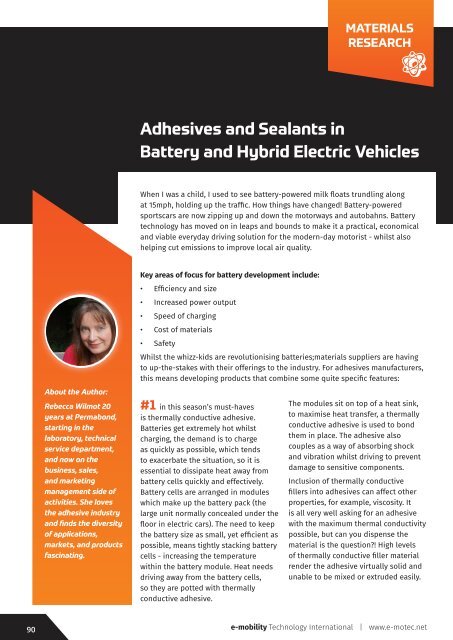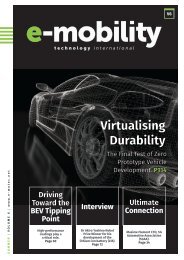E-mobility Technology Winter 2020
Electric vehicle technology news: Maintaining the flow of information for the e-mobility technology sector
Electric vehicle technology news: Maintaining the flow of information for the e-mobility technology sector
You also want an ePaper? Increase the reach of your titles
YUMPU automatically turns print PDFs into web optimized ePapers that Google loves.
MATERIALS<br />
RESEARCH<br />
Adhesives and Sealants in<br />
Battery and Hybrid Electric Vehicles<br />
When I was a child, I used to see battery-powered milk floats trundling along<br />
at 15mph, holding up the traffic. How things have changed! Battery-powered<br />
sportscars are now zipping up and down the motorways and autobahns. Battery<br />
technology has moved on in leaps and bounds to make it a practical, economical<br />
and viable everyday driving solution for the modern-day motorist - whilst also<br />
helping cut emissions to improve local air quality.<br />
About the Author:<br />
Rebecca Wilmot 20<br />
years at Permabond,<br />
starting in the<br />
laboratory, technical<br />
service department,<br />
and now on the<br />
business, sales,<br />
and marketing<br />
management side of<br />
activities. She loves<br />
the adhesive industry<br />
and finds the diversity<br />
of applications,<br />
markets, and products<br />
fascinating.<br />
Key areas of focus for battery development include:<br />
• Efficiency and size<br />
• Increased power output<br />
• Speed of charging<br />
• Cost of materials<br />
• Safety<br />
Whilst the whizz-kids are revolutionising batteries;materials suppliers are having<br />
to up-the-stakes with their offerings to the industry. For adhesives manufacturers,<br />
this means developing products that combine some quite specific features:<br />
#1 in this season’s must-haves<br />
is thermally conductive adhesive.<br />
Batteries get extremely hot whilst<br />
charging, the demand is to charge<br />
as quickly as possible, which tends<br />
to exacerbate the situation, so it is<br />
essential to dissipate heat away from<br />
battery cells quickly and effectively.<br />
Battery cells are arranged in modules<br />
which make up the battery pack (the<br />
large unit normally concealed under the<br />
floor in electric cars). The need to keep<br />
the battery size as small, yet efficient as<br />
possible, means tightly stacking battery<br />
cells - increasing the temperature<br />
within the battery module. Heat needs<br />
driving away from the battery cells,<br />
so they are potted with thermally<br />
conductive adhesive.<br />
The modules sit on top of a heat sink,<br />
to maximise heat transfer, a thermally<br />
conductive adhesive is used to bond<br />
them in place. The adhesive also<br />
couples as a way of absorbing shock<br />
and vibration whilst driving to prevent<br />
damage to sensitive components.<br />
Inclusion of thermally conductive<br />
fillers into adhesives can affect other<br />
properties, for example, viscosity. It<br />
is all very well asking for an adhesive<br />
with the maximum thermal conductivity<br />
possible, but can you dispense the<br />
material is the question?! High levels<br />
of thermally conductive filler material<br />
render the adhesive virtually solid and<br />
unable to be mixed or extruded easily.<br />
90 e-<strong>mobility</strong> <strong>Technology</strong> International | www.e-motec.net









